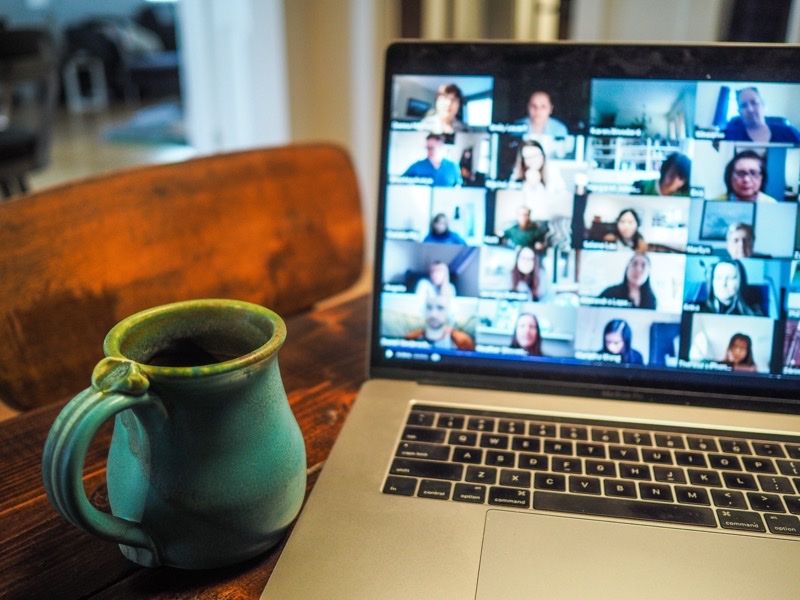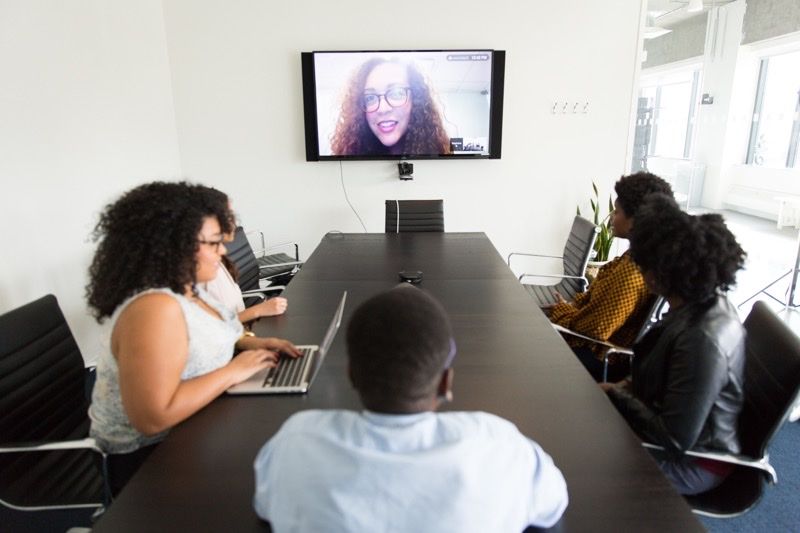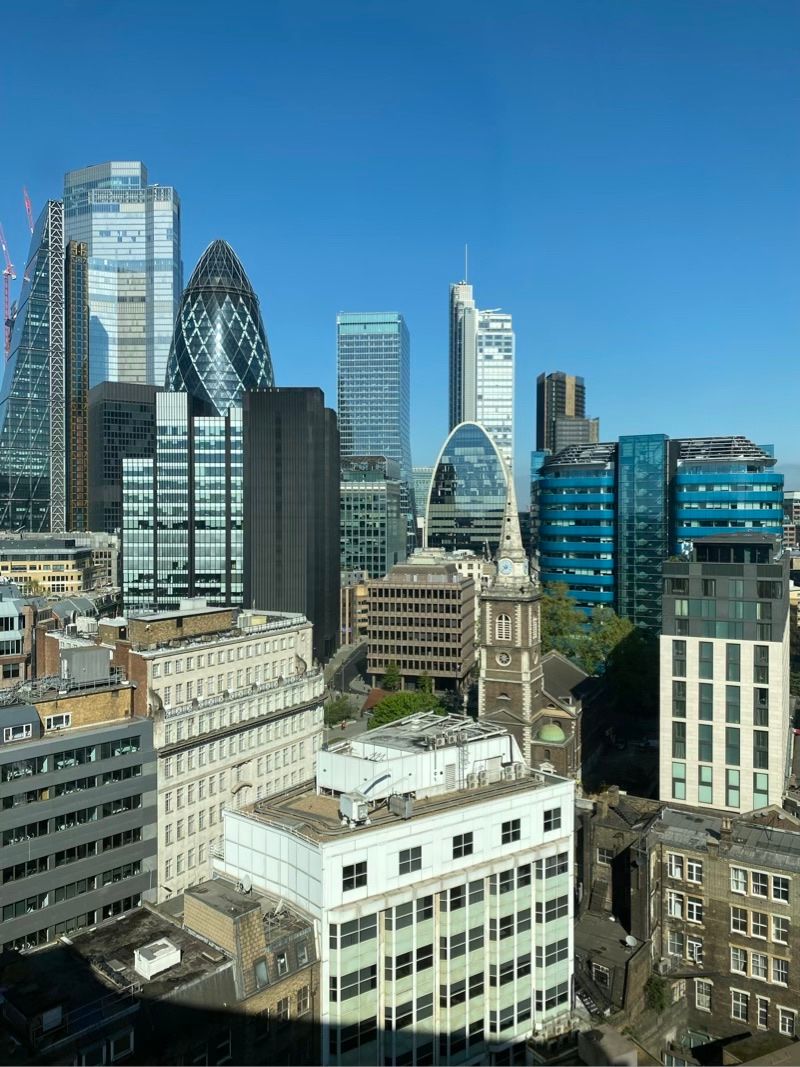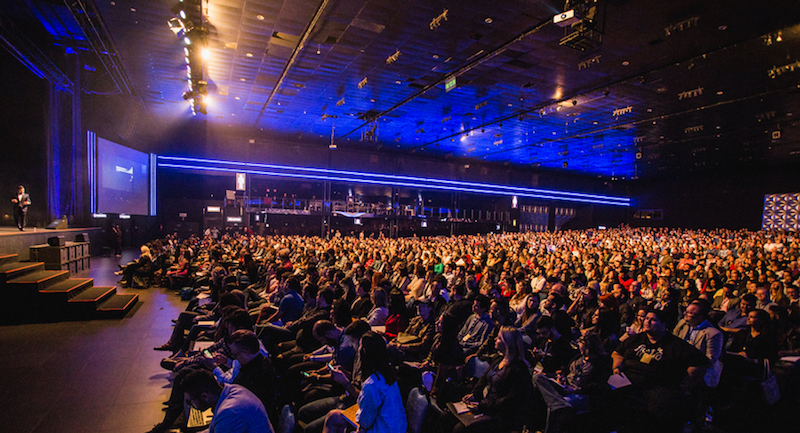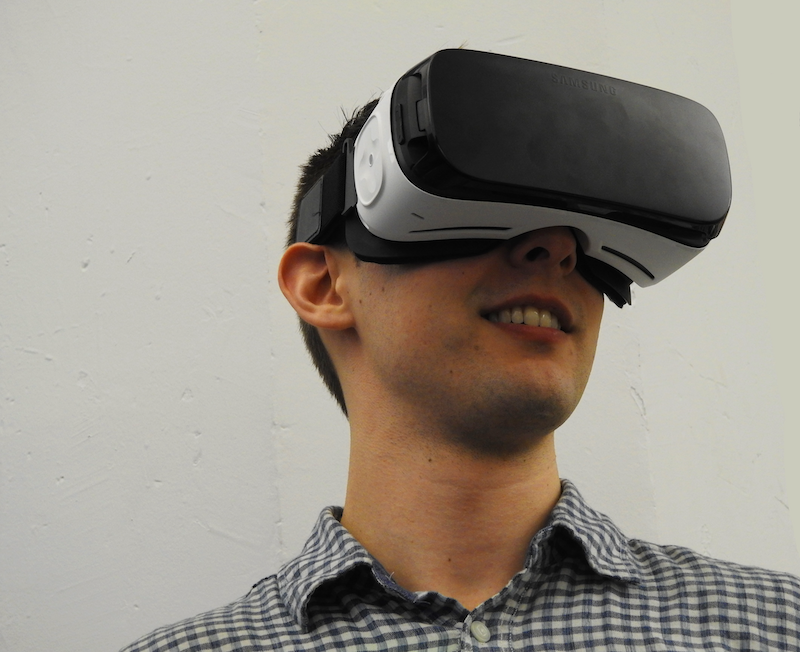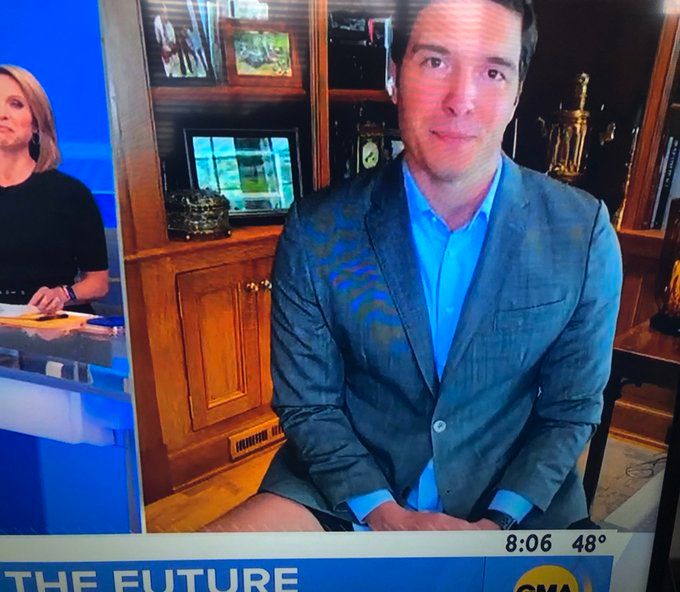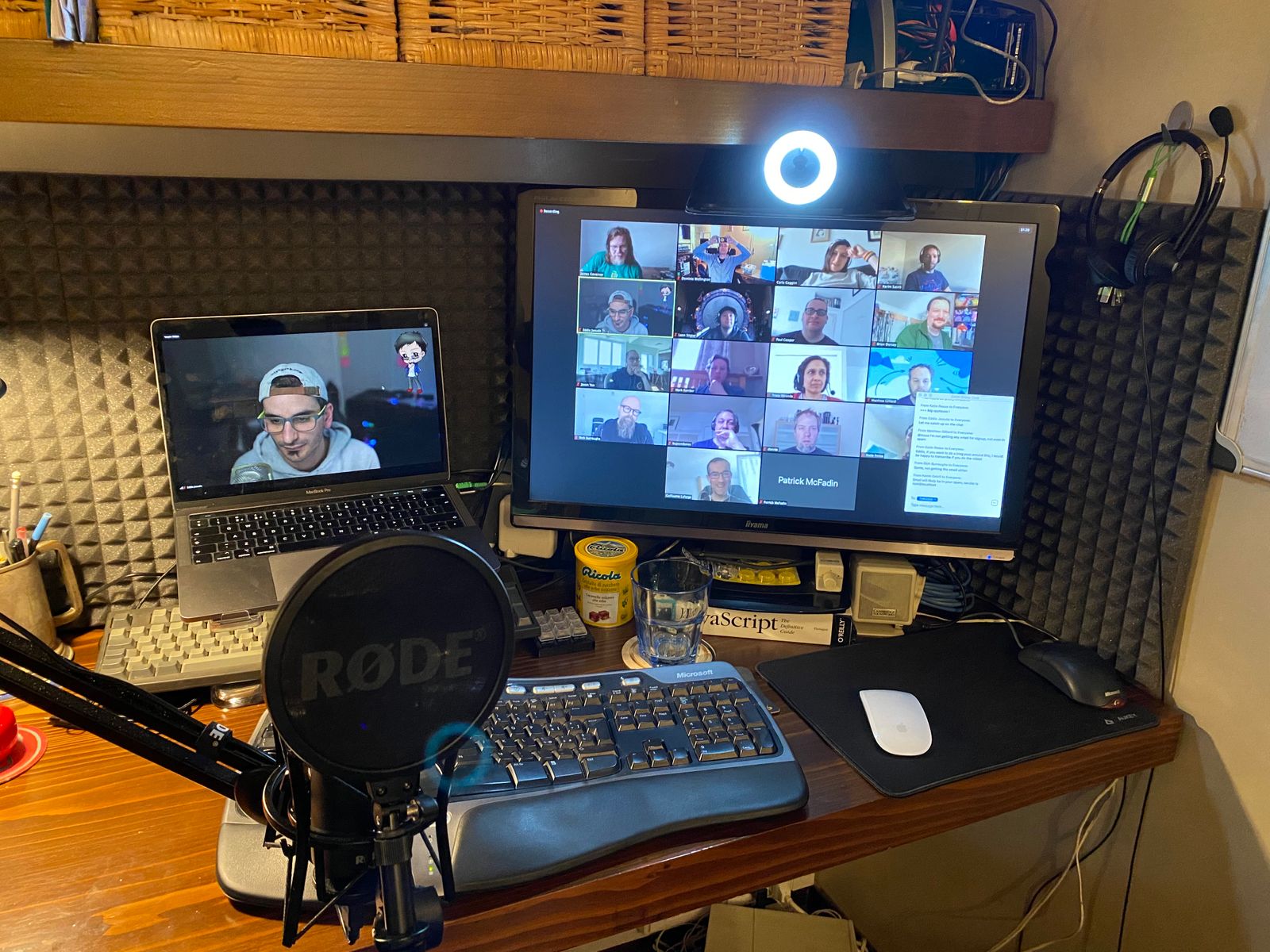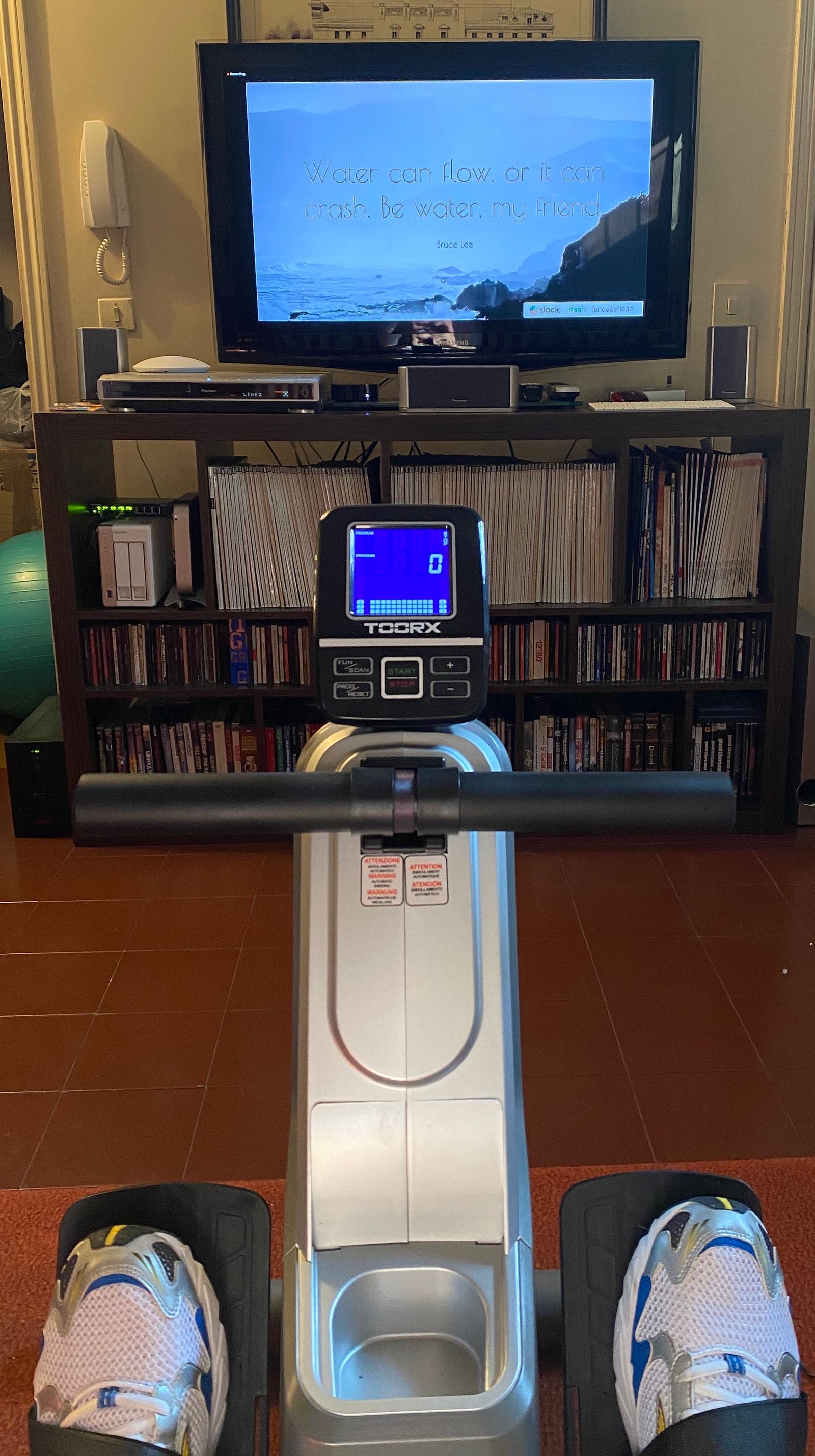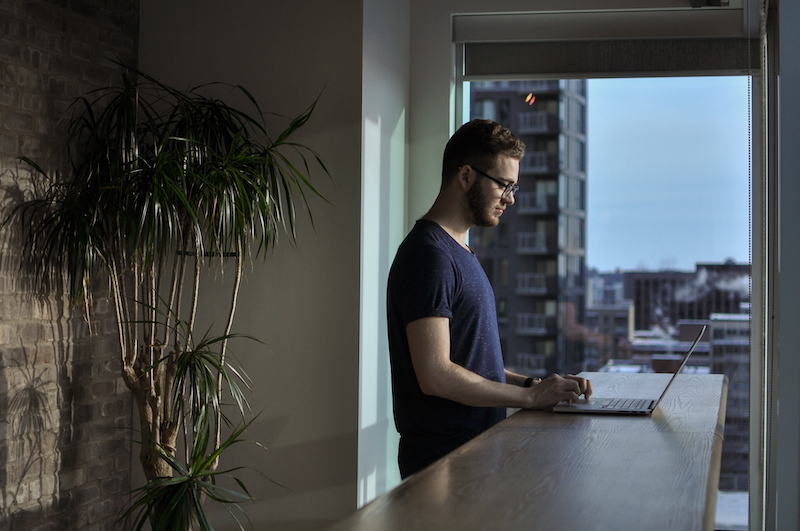Even though travel is (gradually) opening up, I still opted to invest in my home office setup, and I think you should too. Here’s why.
I have been fully-remote for fifteen years now, with only brief interruptions. By that I mean that I have not had a team-mate, let alone a manager, in the same country, and frequently not even in the same time-zone, for that entire time. It’s true that for most of it I have had colleagues in-country, and even offices of varying dimensions and permanence, but they were always in adjacent functions: sales, services, field marketing, and all the back-office functions required to keep an international enterprise functioning.
This means that I am very used to going into an office only rarely, and a setup that lets me work from home has been a requirement for that entire time. The details of my setup have evolved and improved over the years, with increased resources available, and increased permanence to plan for.
The biggest recent change has been recognition that the home office is now a much more permanent part of life. In the Before Times, I would spend a good 50% of my time (if not more) on the road, so the home office was for occasional work. Now, it’s where everything happens, so it had better work well, be comfortable, and look good in the background of Zoom calls.
Here is the current state of the art.
Deep Underground
When we moved into my current place, I earmarked the "tavernetta" for my home office. A "tavernetta" is a uniquely Italian phenomenon: think a US-style basement family room, except that it’s under a block of flats. Several of the flats in my building come with these spaces, but most are only used for storage; a couple are fitted out to be habitable, and mine even includes the luxury of an en-suite bathroom, so I don’t even need to go upstairs to the main family home for that.
There was, however, one minor issue: all of the fittings date back to the Sixties, when this block was originally built. Worse, the flat actually belonged to my wife’s grandmother — so the "tavernetta" is also where my wife and all her cousins held their teenage parties, not to mention her mother and aunts… Out of sight and (more importantly) earshot, but within reach if needed. Anyway, without going into detail, and even though the statute of limitations has long since expired, let’s just say that the furniture and carpets had suffered somewhat over the years of parties.
Over the past summer, therefore, we tore up all the cigarette-burned fitted carpets, ripped out and replaced the ancient and horrible plumbing, and repainted the walls a nice clean white. An electrician was summoned, took one look, sucked his teeth and muttered "vintage", and promptly added a zero to the painful end of his estimate. On the other hand, I do have a lot of electronics plugged in down here, so it’s worth doing it right.

It’s So Bright, I Need Sunglasses
Packing up my desk to make space for all this work was an enormous pain, but I took the opportunity to streamline my setup quite a bit. I was using an ancient Iiyama panel that must be at least a dozen years old; it’s full-HD and was a pretty good screen at the time, but the state of the art has moved on, and the Iiyama is now woefully dim and low-resolution. Worse, it sat between my MacBook Pro and its Retina screen, and a Lenovo 27" panel that I got from work as part of a programme to help employees get set up for work-from-home. The Lenovo has a halfway-house resolution that sits between HD and 4k, but it’s sharp and bright; I run it in portrait (vertical) orientation to look at reference material beside the main screen that I’m working on.
Between those two bright and sharp displays, the Iiyama really suffered by comparison. What I really wanted was a Retina screen to match the MacBook, but Apple only make the monstrous XDR, which is lovely, but costs more than my first several cars — especially once you add a grand’s worth of stand! I put off making a decision, hoping that Apple would finally do what everyone was begging them to and release the 5k panel that they already have in their iMacs as a standalone monitor without a whole computer attached. Apple, in their wisdom, opted not to do this, and offered as a substitute the LG UltraFine. This is supposedly that same panel – but the LG enclosure is ugly as sin, and reports soon surfaced of quality problems: drooping support stands, unreliable USB connections, and even flaky displays. Since the UltraFine is hardly inexpensive, and is also hardly ever in stock, everyone took the hopeful assumption that all these issues meant that surely, soon, Apple would do it right. And so we waited. And waited. And waited.
When last October’s Apple event rolled around with the announcement of the new MacBook Pros, which would have been the obvious time to release a screen to plug the new laptops into, and Apple still didn’t — that was when I snapped. I went out and bought an LG 5k2k Ultrawide panel. The diagonal is a huge 34", but it’s actually only the height of a 27", just stretched out wiiiiide. The picture is sharp, the screen is bright, and the increase in real estate is incredible. As with most "tavernette", mine is partly below street level, and my desk is in the back of the room (it’s fixed to the wall and can’t move), so more light is very welcome. I also added an LED strip above the monitor, and my webcam (a Razer Kiyo mounted on the shelf above the desk) has a ring light, so I think my SAD countermeasures are sufficient for now.
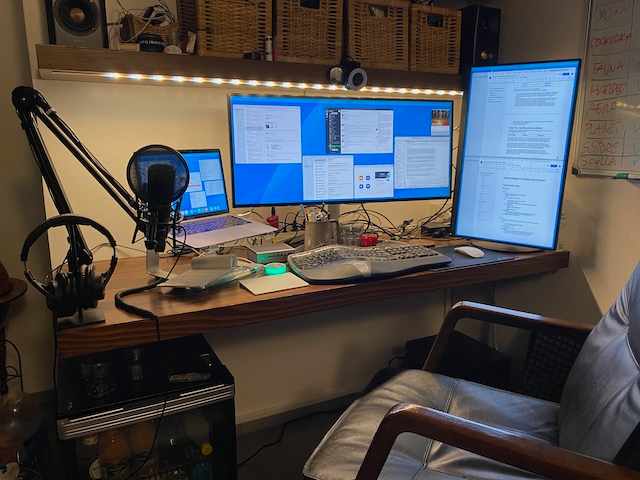
That desk is my working desk, so the only thing that gets plugged in there with any regularity is the MacBook Pro I get from work. I have it on a stand so that it’s at the level of my sight line, and aligned to the monitors too. Before, I had a combo USB hub, USB-C power pass-through, and HDMI adapter Velcro’d to one of the legs of the laptop riser, and that went into one USB-C port, while a second USB-C cable fed the Lenovo. I then had a bunch of USB-A peripherals depending either from that hub or from the USB hub in the back of the Lenovo: keyboard, webcam, microphone, audio device, Ethernet adapter and MuteMe hardware mute button.
I was never super happy with this setup, and with the advent of the monster LG panel, I had an opportunity to redo it properly. Now, I have a single Thunderbolt cable coming out of the MacBook Pro, that takes care of power and all data connections. That cable goes into a CalDigit TS3-Plus dock that feeds everything else: DisplayPort to the LG, Mini DisplayPort to the Lenovo, (gigabit) Ethernet, SPDIF for audio, and powered USB-A for keyboard, webcam, microphone, and MuteMe button — with several more ports still available.
I favour a Microsoft Natural ergonomic keyboard. This is a split keyboard; the benefit is that your wrists do not bend while using it, as they do for straight keyboards such as the ones built in to laptops. It took a little while to get used to, but it’s very comfortable, and I could never go back. It works fine with a Mac, especially once you use Karabiner-Elements to remap some important keys.
My setup is also ambi-moustrous: I have an Apple Magic Mouse on the right of the keyboard — and a Magic Trackpad on the left. This setup lets me alternate my pointing hand to avoid stressing my right hand and wrist, as well as opening up the possibility of trackpad gestures without having to reach up to the MacBook’s trackpad, which is elevated some way off the desk and not exactly natural to use.
Make Some Noise
The audio situation is also worth touching on for a moment. Previously I was running a CambridgeWorks 4+1 speaker setup that I got with a Soundblaster Live! card more than twenty years ago. They were fine for what they are, but Macs never properly understood them, even with a dedicated USB audio interface that has separate front and rear audio outputs. (The system’s audio setup utility can play test audio through each of the four speakers, but in actual usage, the rear pair make only the faintest noise.) On the other hand, I did like having a physical volume knob on my desk, so I could crank it all the way to the left and be certain that nothing was going to make noise, no matter what.
I replaced these with an Edifier 2+1 set of bookshelf speakers with a monster subwoofer — seriously, the sub is bigger than both speakers together, and by a substantial margin (you can just about see it under the desk in the pic above). They are fed by an optical fibre cable from the CalDigit dock, and sound absolutely fantastic! They also have their own remote, which still lets me mute them without having to trust that some piece of software won’t decide that it’s important to unmute for some reason.
I also have my podcasting setup: a Røde NT-USB microphone that plugs into the CalDigit dock, and a pair of audio-technica headphones that plug into the Røde. The mic is on a spring arm so that I can fold it out of the way when I’m not using it, and the headphones have their own stand to keep them out of mischief.
This is the best setup for me: a single cable to plug in, and the MacBook is docked to all of this setup — and when it’s time to go, one cable unplugged and I’m ready. I keep go-bags of cables and power bricks in both of the bags I use when I leave the house, so I just need to make sure the actual laptop is in there and I’m good to go.
Away From Keyboard
Beyond what is on the desk, my home office includes a few more amenities. There is a mini-fridge under my desk with drinks — mainly sparkling water (tap water plus Sodastream bubbles), but also a few fruit juices and the like for when I fancy something different, and a couple of beers in case of particularly convivial Friday afternoon meetings (although it’s been a while since I’ve had occasion to drink one). I also have an electric Bialetti moka coffee pot for when it’s stimulation that I need rather than relaxation.
Yes, there is a printer down here! After some unpleasant experiences with inkjets, I lived the paperless lifestyle for a long time, but finally caved and bought a laser printer in 2019. At the time I assumed it would remain largely unused, and if I’m honest, I only bought it to placate my wife — who was of course very soon proved to be not only Right (again), but scarily prescient, as we spent much of 2020 in home-schooling mode, printing reams of paper every day. Utilisation has died back down a bit now, but the benefit of laser printers is that they don’t dry up and gunk up their print heads if you don’t print every five minutes.
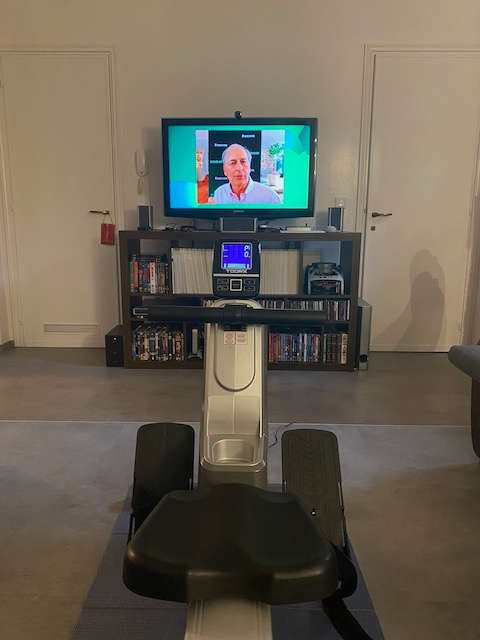
Moving away from the desk area, I also have a TV down here with a rowing machine in front of it. The TV is passed down from when the main living room TV got upgraded to 4k, but it’s still perfectly serviceable. It’s not connected to an actual TV antenna down here; instead, I have an AppleTV device plugged into it, which means I can AirPlay content to it from my MacBook. How this plays out is that when I am attending a webinar or any sort of camera-off passive presentation, I stream that to the TV screen (without having to disconnect from the desk), and follow the webinar from my rowing machine, getting an education and a workout at the same time.
Make Space
With remote work and work-from-home becoming normalised, at least part-time, I would recommend to everyone that they invest in their home-office setup. I am very conscious that not everyone has the luxury of a dedicated room — but remember, I have been building up to this dream setup for a long time. If you are able to set yourself up with even a desk in a corner, that will help to confine work to that space. The physical separation gives "I am going to work" and "I am leaving work" rhythm to your day. There’s also a practical benefit to having somewhere to leave work in progress, notes, or whatever without that stuff cluttering up space you need for other purposes (a table you need to eat meals off).
You should also do the best you can in terms of height of desk, chair, keyboard, and screen. Yes, those last two are separate; laptops are an ergonomic nightmare if you are going to be using them all day, every day. Investments in your working environment will pay substantial dividends in terms of physical and mental well-being. It doesn’t have to be a huge expense, either; IKEA stuff is pretty good.
Don’t be put off by the thought that this is all nerd nonsense. Remember, programmers and gamers care deeply about the ergonomics of their computers because they spend a lot of time using them. These days, that describes most of us in white-collar jobs. Leaving aside some of the questionable choices gamers especially might make in terms of the aesthetics of their rigs, there is a lot to learn from those groups. Big screens, comfortable keyboards and mice, and some attention paid to how those devices are laid out in relation to one another, will all make your work life much less painful.
If you don’t have room for a rowing machine — or a Peloton, or a treadmill, or whatever — you may be able to simply exercise in front of your computer screen, depending on personality and the sort of exercise you favour, without needing special equipment and the room to set it up. I would definitely suggest making time for physical exercise, though; a walk around the block before sitting down to work, a run between meetings, or a sneaky bike ride over a lunch break — whatever works for you. I got into the habit of taking a mental-health day every couple of weeks when I was otherwise not leaving the house, and getting on my bike and just disappearing up into the hills. Your precise needs may vary, but try to make room for something in your routine.
And here’s hoping that we get to vary the work-from-home routine with some (safe) in-person interaction in 2022.
